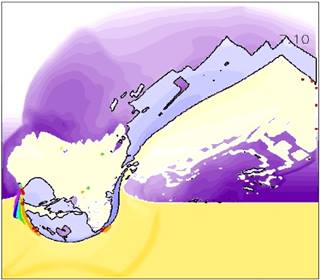Barringer Crater. Route 66
Index to this page
About Barringer Crater, Arizona
Facts, Trivia and useful information
Elevation 5,400 ft (1.647 m). Population n⁄a (2025).
Time zone: Mountain (MST): UTC minus 7 hours. Summer (DST) no DST⁄ PDT (UTC-7).
Barringer Crater or Meteor Crater is a natural landmark near US Route 66 (just 5.8 miles south of I-40's Exit 233) in Coconino County, in the central part of Arizona. This is a Map of Barringer Crater.
Barringer Crater seen from the air.
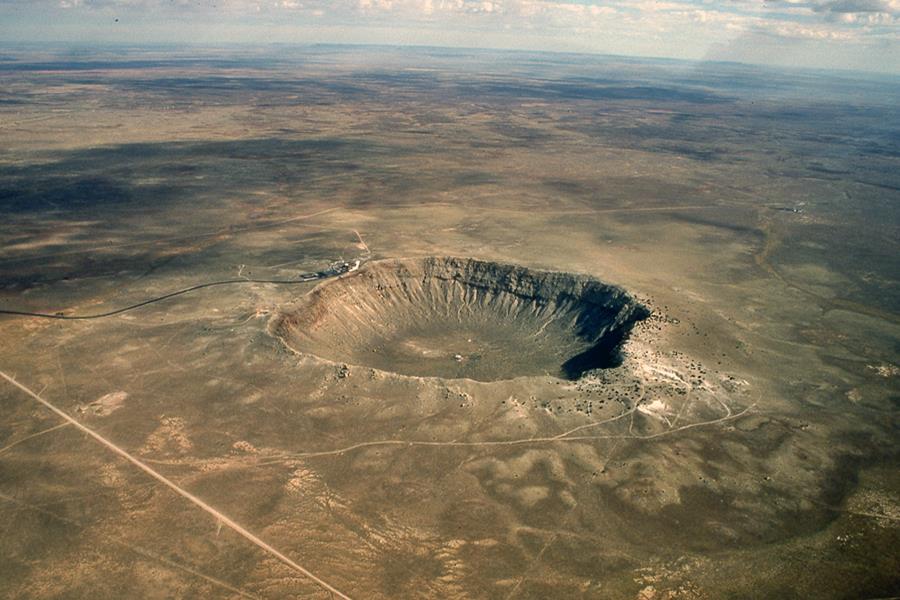
For the early history of the area around Barringer Crater, please read the History of Winslow, located very close to the Crater.
The old wagon trail that linked Winslow with Flagstaff was surveyed in the early 1880s, and the Atlantic and Pacific Railroad, which later became part of the Atchison Topeka and Santa Fe Railroad (AT&SF) built a railroad through this barren region. The tracks are located to the north of what would later become "Meteor Crater".
A station named Sunshine was built about 1 mile north of I-40's Exit 233, and 6 miles to the northwest was the town of Canyon Diablo, now a ghost town. Further north lay the land of the Hopi and Navajo Reservations.
The Name: Barringer Crater
The place is named after the meteorite impact crater (Barringer Crater) which in turn was named after Daniel Barringer who suggested its meteoric origin when most scientists believed it to be an extinct volcano.
When Route 66 was created in 1926 it was aligned through the area along the National Old Trails highway. The road was realigned later in the 1940s. During the 1970s, the freeway (I-40) was built and it included an exit that provides easy access to the Crater.
Getting to Barringer Crater
To the east past the "ghost towns" of Meteor City and Leupp Corner is the town of Winslow followed by Joseph City and Holbrook. Head west to Winona and Flagstaff and stop to visit Twin Guns and Two Arrows.

Where to Stay. Find your Hotel
There is no lodging on Route 66 in Barringer Crater other than the RV Camp, but you can find hotels nearby in neighboring Twin Arrows and Winslow
>> Book your Hotel in Winslow
or
Twin Arrows
More Accommodation near Barringer Crater on Route 66
There are plenty of lodging options in the cities and towns along Route 66 east and west of Barringer Crater; click on the links below to find your accommodation in these towns, listed from east to west:
Eastwards
In Arizona Along Route 66
Westwards
You are so close to Las Vegas and the Grand Canyon!
>> There is a RV campground in Barringer Crater
Weather in Barringer Crater

Location of Barringer Crater on Route 66
The climate of Barringer Crater is dry, temperate and arid. Relative air humidity is low and this leads to wide variations beween night and day temperatures all through the year, causing hot dry summer days but cool summer nights and cold winter ones.
During summer (Jul), the average high temperature is around 94.5°F (34.7°C) and the average low is 61.9 °F (16.6°C). In winter the average high (Jan) is 49.5°F (9.7°C) and the average low is about 20.8°F (-6.2°C), well below freezing pont.
As expected for an arid area, rainfall is scarce: 6.99 inches (178 mm) yearly and about half of it falls from July to September (3.1 in. - 79 mm). Snowfall is also light, with only 6.4 inches (16.3 cm) per year, between Oct. and April.
It is sunny in Barringer Crater, only 53 days per year are days with precipitation.
Tornado risk
There is almost zero tornado risk in Barringer Crater: Coconino County has no Tornado watches. The area west of the Rocky Mountains has virtually no tornado events at all.
Tornado Risk: read more about Tornado Risk along Route66.
Map of Route 66 in Barringer Crater AZ
Read the Detailed Description of this segment (Winslow to Winona). Below is the interactive map:
>> Custom map of Route 66 in Barringer Crater
Check out the alignment of Rotue 66 in Meteor Carter by clicking on the image, or visit our Route 66 Map of Arizona, with the all the alignments of US 66 and all the towns along it in the state of Arizona.
The color key for this map is the following:
Pale Blue: the N.O.T. and the 1926 to 1940s alignment; it can still be driven. It links to the missing section (see further down) in yellow at the rest area.
Black: just south of the freeway, east of the rest area, it can be driven and carried US66 from the N.O.T. days until 1969.
Blue: the Red Ranch Gap Rd., carried Route 66 from the N.O.T. days until the 1940s.
Route 66 Alignments over the years
There were several alignments of the Mother Road close to the meteor crater and you can see them in our custom map with the missing segments of Route 66 in eastern Arizona. This map's color coding is the following: yellow, the highway from National Old Trails to the mid 1960s.
Route 66 Alignment near Barringer Crater
With maps and full information of the old roadway.
- Winona to Williams (next)
- Winslow to Winona (Barringer Crater's)
- Lupton to Winslow (previous)
Barringer Crater, Arizona, its Sights and Attractions
Things to Do and Places to See
There are some remains of Route 66 significance and, of course, the gigantic crater which is the must-see sight.
At the Meteor Impact Crater
Barringer Crater or Meteor Crater is an amazing natural landmark just south of US 66; it has a Visitor Center and, closer to Route 66 an RV camp and service station.
Historic context, the classic Route 66
When Jack DeVere Rittenhouse published his "A Guide Book to Highway 66" in 1946 he detailed the attractions along Route 66, which included Leupp Corner and Meteor City". He mentions how the road wound across the hilly contryside and, 3 miles west of Meteor City, the Meteor Crater Observatory, which he noted as "Admission is free, and a stock of curios for sale". Just one mile west was Rimmy Jim's Service Station which had cabins built to look like Navajo hogans, lunchroom and gasoline. You could buy tickets to visit the crater for 25 cents per person (now it costs $20, that is inflation for you). Further west, 4 mi from Rimmy Jim's was Two Guns.
Sights
Head south from I-40s Exit 233 along Meteor Crater Road and after 0.4 mi. you will reach the junction with Old Route 66, which has an east to west course. To the right is the RV campground and service station. Notice the dome shaped shop, evoking the now closed Meteor City Trading Post.
Meteor Crater Observatory
Take a left to visit the Meteor Crater Observatory, 0.6 mile towards the east along Old Route 66. (See Map with directions).
The street view of the ruins of the Meteor Crater Observatory nowadays:
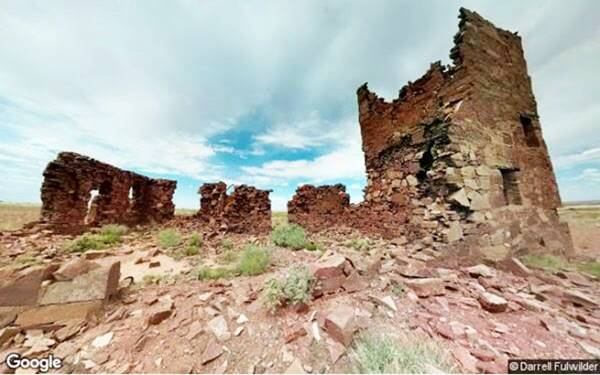
Click image for Street View
Looking at the remains of the building, it is hard to imagine that it once looked like a castle. The postcard below is a view of the same building, the Meteor Crater Observatory. It was printed in the 1940s.
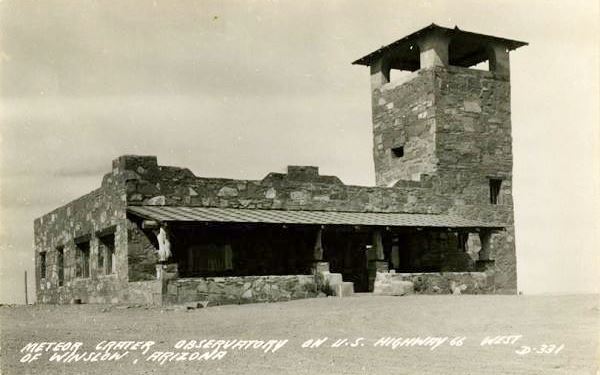
The rock building that resembled a castle was built by Harry and Hope Locke around 1935 with sandstone rock bricks. Although Harry died during construction, his widow opened the observatory in the late 1930s. But it was not the best time, the Great Depression still hurt business, and World War II killed tourism until 1945. So the observatory closed after a few years.
It reopened in 1946 when Dr. Harvey H. Nininger leased the building and used it for a museum, workplace, laboratory and home.
Dr. H.H. Nininger
Dr. Harvey Harlow Nininger (1887 - 1986) was a meteorite hunter and expert in all things relating to meteorites.
Nininger curated the museum he had founded. He also assisted in the investigation of the alleged Roswell "UFO crash".
The crater is located 6 miles south of the observatory. The visitors driving along Route 66 would stop at the observatory and take a peek at the crater through a telescope.
It was known as the American Meteorite Museum and was the first privately owned meteorite museum in the world, and of course it exhibited meteorite fragments. The "castle" closed in 1953 and the Museum relocated to Sedona, Arizona, 1953-60.
The building began to fall apart, and now only a few walls remain standing.
Rimmy Jim's Trading Post
Now gone
On the north side of I-40 right at the Exit 233, westbound.
Rimmy
The origin of Rimmy Jim's nickname is uncertain. There are two theories, one, is that he lived near the "rim" of the crater, the other that he was a "rimmy" cowboy who rode a "Rim-fire" or double-cinch saddle, common in Texas, where he was born.
James ("Rimmy Jim") Giddings was born in Cleburne TX in 1873 and died in Winslow, AZ, 1943. He moved to Arizona around 1908 and never got married. He opened his trading post in 1928 shortly after Route 66 was created.
He was quite a character and his store was decorated with signs and cartoons indicating that he disliked salesmen.
Salesmen were not welcome
One sign depicted a sturdy man (Rimmy) with a shovel in his hand walking away from a grave. The caption states: 'Stay from behind this counter - "When I tell'em to stay from behind my counters I mean it"', and the tomb stone declares: "Here lies the man wh had no fear. He went behind Rimmy's counter for a bottle of beer", the foot of the poster says "Rimmy has started his own grave yard. 40 miles east of Flagstaff, Ariz."
Another poster drawn like a cartoon showed Rimmy's face and several salesmen: it stated 'Meet "Rimmy Jim" the only man in the world that loves a salesman, God help the poor salesman on his first visit at Rimmys. Salesmen's time -5- minutes. The salesman who hung around too long "He's dead"'.

1930s photo of Rimmy Jim
Credits
The photograph shows a view of the store and a "coffin" painted on its wall, the caption is "For all salesmen: free beheading and coffin fitting by courtesy of Rimmy Jim's Trading Post. Highway 66".
His succinct obituary published in the Arizona Champion ⁄ Coconino Sun (Flagstaff, Arizona) read: "Past 15 years owned the Meteor Crater Junction service station,40 miles east of Flagstaff.".
But the store survived him and is said to have burned around 1969, it was located on the later 1947 alignment of Route 66. No traces remain of the original building.
Some mistakenly attribute the Two Guns tower "Fort" and Canyon Lodge as being the original 1926 site of "Rimmy Jim's", but it was not his, it belonged to Harry E. (Indian) Miller.
"Rimmy Jim's" Service Station in 1950s and nowadays (gone) Route 66
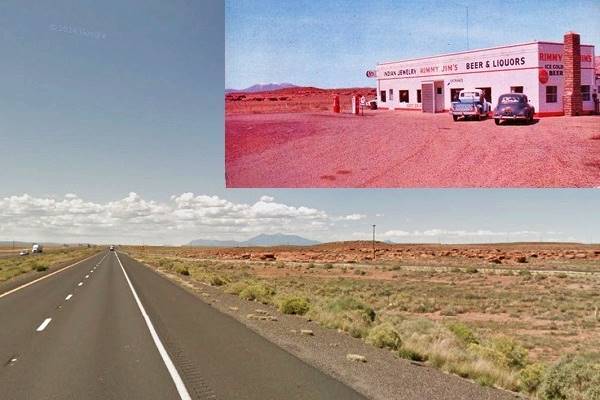
Click on image for Street View
The mountains on the horizon, the nearby ridge and the sandstone formations close by clearly identify this spot shown in the image as the location of the old service station and trading post. But nothing remains of it.
The Meteor Crater: Barringer Crater
From I-40 Exit 233, head 5.8 mi. south along Meteor Crater Rd. until you reach the Visitor Center next to the north rim of the crater.
U.S. National Natural Landmark
The crater was considered the most mysterious geologic feature in the West . Originally it was named "Crater Mound" and "Coon Butte".
From afar it looks like a low ridge, but this is the ridge formed by the rim of the crater, which is a circular depression about 4,000 ft. in diameter.
The crater is well visible because it is located in a very arid region, a desert, devoid of vegetation. Although it was more humid in the past, its dry conditions have preserved the crater fairly well.
Erosion has not degraded the crater but the flat floor inside the crater is due to lake sediments that settled there during a wetter period. The rubble from the rim has fallen into the crater forming "Talus cones" (a mantle of debris below the outcrop broken off by weathering and erosion).
Meteor crater or Meteorite Crater?
Actually, it is a Meteorite Crater; a meteor would have burned up in the atmosphere. Only a meteorite can punch a crater into the ground.
Meteoroids are objects in space that range in size from dust grains to small asteroids.
Think of them as "space rocks".
When meteoroids enter Earth's atmosphere (or that of another planet, like Mars) at high speed and burn up, the fireballs or "shooting stars" are called meteors.
When a meteoroid survives a trip through the atmosphere and hits the ground, it's called a meteorite. NASA
Meteoroid, Meteor and Meteorite
There are many bodies that orbit around the Sun: the planets, their moons, the asteroids, comets and also, smallers chunks of rock known as "meteoroids".
Most of the meteoroids are formed from the remains of ancient comets, the dust and rock that was embedded in the comets ice are released after each successive close encounter with the Sun. Other meteoroids are formed by the collisions between asteroids, which generate small fragments. Some are even ejected into space from Mars when large meteorites impact the Martian surface.
These meteoroids are mostly small and the gravity of the planets and Sun tug them about so that their orbits are modified in such a way that they intersect the Earth's orbit, colliding with our planet.
Most of them are small pebbles or tiny boulders. They enter the Earth's atmosphere at high speed and the friction with its gases heat it and vaporize it. These are known as "meteors", and we can see them burning upon entry as "shooting stars".
Some meteors are large enough to survive burn up and impact the Earth's surface, these are known as "meteorites".
Volcano or Meteor?
In 1891 Albert E. Foote wrote the first paper suggesting its meteoric impact origin. He gathered over 600 lb. of tiny fragments of meteoric iron as proof.
The following year Grove Karl Gilbert, the chief geologist for the U.S. Geological Survey lectured about its volcanic origin. He believed that a steam explosion had caused the crater and that the lack of
magnetic anomalies were proof that no large iron body was buried under the crater.
At that time the impact mechanics of meteors was not well known, and that is why Gilbert overlooked the fact that most of the meteorite was vaporized upon impact and therefore there was little iron left in the crater.
Daniel Moreau Barringer (1860 - 1929) was a wealthy businessman who had made a fortune with silver mining in Arizona and he believed that there was plenty of iron to be mined at the crater.
He organized the Standard Iron Company and staked a mining claim on 640 acres (259 ha.) surrounding the crater in 1903. He lobbied to have a post office, which opened in Meteor, Arizona in 1906.
He championed the meteoric origin and wrote a paper with Benjamin Chew Tilghman in 1906 that was published in the Proceedings of the Academy of Natural Sciences in Philadelphia.
George Perkins Merrill supported the meteor impact and wrote a paper titled "The Meteor crater of Canyon Diablo, Arizona its history, origin and associated meteoric irons", 1908. So did Herman L. Fairchild with his "Origin of meteor crater (Coon butte), Arizona", 1907.
But Barringer never found any large lump of iron (he expected to find ten million tons of it), so skepticism on the meteoric origin of the crater prevailed.
Ninninger (who ran the nearby Meteor Observatory) discovered particles formed by the fusion of local rocks that contained magnetite spheroids with cobalt and nickel these particles of glass slag were named impactites and clearly could not have been produced by a volcano, only by a meteorite.
But total proof would have to wait until 1959 when Eugene Merle Shoemaker (1928-1997) confirmed Barringer's hypothesis in his Ph.D. Thesis
Shoemaker's proof was the presence of two very rare forms of silica which are created under extreme pressure for very short period of times, like those encountered in a meteor impact event. No volcano can produce these forces.
See this simulated meteor strike created by the University of Iowa that shows how the meteor struck the ground and vaporized.
Barringer Trivia
- A small lunar crater on the far side of the Moon is named after Daniel Barringer.
- After Shoemaker's death, the Lunar Prospector space probe carried his ashes to the Moon, and he is the only person buried there.
- The largest fragment yet discovered of the meteorite that impacted here is the Holsinger meteorite, you can see it and touch it at the Meteor Crater Visitor Center.
- NASA astronauts trained in the crater during the 1960s preparing for the Apollo Moon missions
Evidence of the Meteoric Impact
The impact thrust the sandstone upwards and outwards so that it fell on the deformed rim (which had been pushed up). You can see the uppermost layer of white colored Coconino sandstone (265 million years old) the "ejecta" lying on top of the red Triassic sandstone that forms the upper layer of the terrain (245 million years old)
This inverted stratigraphy has the layers of rocks stacked in the reverse order to which they normally occur. So the older white rock overlies the younger red rock, indicating that it was formed by an impact.
From Iron Mine to attraction
Barringer's company spent over $600,000 on the mine and found nothing. He passed away in 1929 and the mining operations ceased. His wife and children formed the Barringer Crater Company and have operated it to this day.
The Crater in figures
- Diameter: 0.737 miles (1,186 m).
- Depth: 560 feet (170 m)
- Rim rise: 148 feet (45 m)
- Meteor diameter: 160 feet (50 m)
- Meteor type: iron meteorite
- Mass: 300,000 tons.
- Impact speed: 28,600 mph (12.8 m⁄s)
- Impact energy: 10 megatons
- Rubble layer thickness: 690 - 790 ft. (210 - 240 m) above the bedrock

Adapted from a NASA photo
The crater's name: Meteor Crater
The United States Board on Geographic Names assigns the names of natural features based on the nearest post office. So, as the nearest post office was the one located in the now defunct town of Canyon Diablo, the crater was known as Canyon Diablo Crater, and some iron fragments recovered from the impact are known as "Canyon Diablo Meteorite".
Later the Meteor post office opened next to the crater and it was renamed as "Meteor Crater". The scientific community knows it as "Barringer Crater" after Daniel Barringer who was the first to suggest its meteoric origin.
Visiting the Crater
It is a privately owned landmark despite being designated as a National Natural Landmark, it is not a National Monument (which would need it to be owned by the Federal government).
There is an admission fee charged to see the crater, and the Meteor Crater Visitor Center located on the north rim has interactive exhibits and displays, including the American Astron aut Wall of Fame, a part of an Apollo craft and the largest piece of the meteorite.
There is a gift shop, three lookout points and guided tours too. Give yourself around 1.5 hours for the Discovery Center and at least 1 hour for the guided rim trail tour.
Visit the website: meteorcrater.com for more information.
Walk all around the rim of the Barringer Meteor Crater
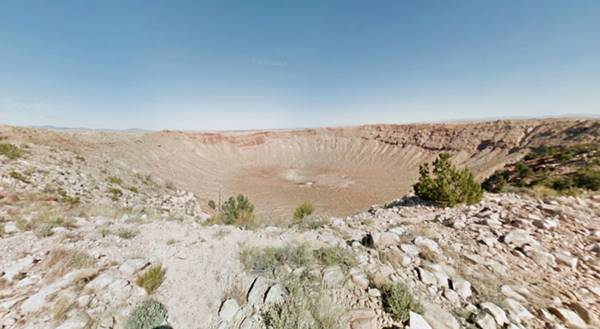
Click on image for an Interactive walk along the whole rim
On other meteorite impacts
The impact of Barringer's Meteorite
This meteorite struck the ground about 50,000 years ago and ejected 175 million tonnes of rock creating this "Meteor Crater".
The iron bolid was about 100 to 164 ft in diameter (30 to 50 m) and it caused some significant local damage.
At that time there were no people in America, the first humans reached the New World some 20,000 years ago, but there were plenty of animals in the area.
There was a juniper-pinyon forest in what is now a desert, and megafaunal mammals lived there (mammoths, camels, tapirs, horses and giant ground sloths).
The impact zone would have experienced a 20 to 40 megaton bast -equivalent to 1,300 to 2,700 bombs the size of the one that razed Hiroshima, Japan in 1945.
The impact ejected red hot rocks and molten meteorite fragments over 1 mile from ground zero (1 to 2 km), all animals in that area would have been vaporized.
The shock wave would have blasted the air outwards at an explosive sub-sonic speed (620 miles per hour, 1,000 km⁄h) killing all animals and flatenning trees to a distance of about 10 miles (16 km). Rocks and branches moving in the shock wave could have injured animals up to 15 miles (24 km) away.
The dust cloud and the smoke from the burning woodland would have had a regional impact, but did not affect the global climate or cause extinctions. Rain and snow melt filled the depression with a during the subsequent Ice Ages, when the climate was more humid.
The NASA and its Near Earth Object Program
Meteorites are mostly harmless, thousands of tonnes of meteor dust falls on the surface of the Earth each year. Some meteorites reach the surface but are seldom noticed as they are mostly small.
But on occasions larger bodies strike our planet and gouge out large craters like Barringer Crater, or even bigger. Their consequences depend on their size...
Collision size and frequency
- 13 ft. (4 m) meteorites strike Earth once a year.
- 23 ft. (7 m) meteorites impact Earth every 5 years.
- 164 ft. (50 m) bodies collide once every thousand years.
- 0.6 mi (1 km) bodies hit the Earth every 500,000 years.
- 3.0 mi (5 km) asteroids hit us every 20 million years.
- 6.0 mi (10 km) asteroids at least every 66 million years.
The Chicxulub crater in the Yucatán Peninsula in Mexico caused the Cretaceous–Paleogene extinction (which wiped out the dinosaurs) 66 million years ago. The crater is over 110 mi (180 km) in diameter and 12 mi (20 km) deep. It was formed when a 6 mi. (10 km) body crashed into the Earth.
The Tunguska meteor that exploded in mid-air over the forests in Siberia in 1908, was about 200 to 620 ft. wide ( 61 to 190 m) and had the kick of 1,000 to 2,000 atomic bombs like the one dropped on Hiroshima. It fellled over 80 million trees covering an area of 830 sq. mi. (2,150 km2).
With this in mind, the NASA keeps an eye on asteroids and comets that many move close to the Earth's neighborhood, they are Near-Earth Objects (NEOs). The largest known NEO is 1036 Ganymed with a 19.7 mi. diameter (31.7 km).
Dome at the RV Park
There is a magnificent dome structure at the gas station by the RV Park. It is pictured below.
The Meteor Crater location scene nowadays (crest has gone), notice the two windows, close together and rectangular.
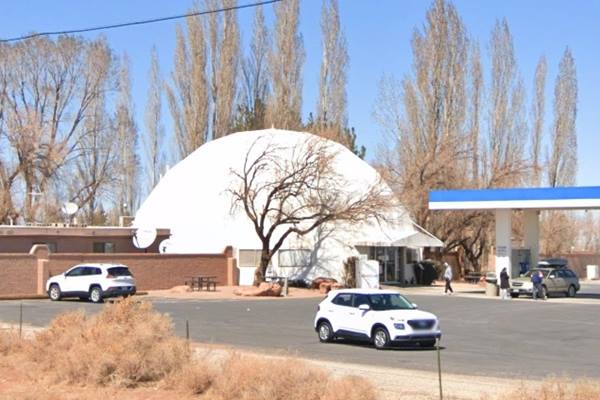
This was the location of some scenes of the 1984 movie Starman, starring Jeff Bridges. It was also one of many domes owned by Mr. Ortega (others were located along Route 66 in Meteor City, Houck and Lupton).
We describe the movie Starman in our page on Meteor City, where we also discuss the different domes along Route 66.
Below are two stills from the movie shot here, at the dome in Barringer Crater:
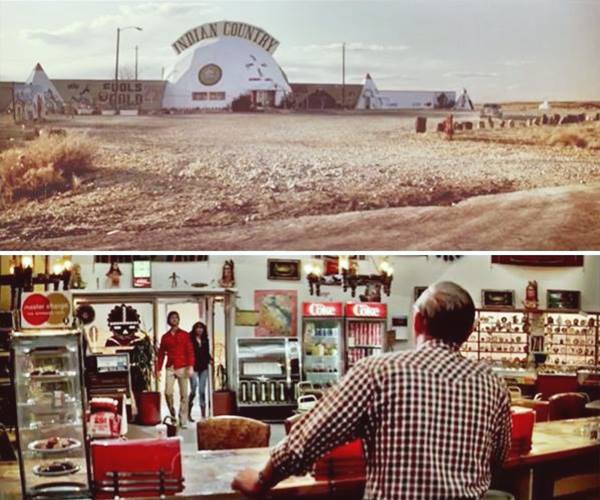
But Meteor City wasn't the location. These scenes were shot at the dome in Barringer Crater.
Bridges was nominated for the Academy Award for Best Actor for his role.
Continue your Road Trip
This marks the end of your stop at Meteor Crater, head west intoTwo Guns to continue your Route 66 Road Trip.
Nature and Outdoors
Tip: consider visiting the Grand Canyon on your Road Trip.
Some tours and sightseeing
Sponsored content
Lake Havasu City

Lake Havasu City, the lake and London Bridge. Source
The resort town of Lake Havasu City on Lake Havasu has beaches along the lake's scenic shoreline, an active nightlife and the original London bridge (you can take a Tour to visit it)
The adjacent state park is open 24 hs, and there is an entrance fee. It is located on a reservoir on the Colorado River. You can hike and enjoy the riverside.
Visit the scenic shoreline with beautiful beaches, nature trails, boat ramps, and many convenient campsites.
>> Book your Hotel in Lake Havasu City
Learn more about the outdoor sites in the Havasu State Park official website.
>> Book your Hotel in Flagstaff AZ

Credits
Banner image: Hackberry General Store, Hackberry, Arizona by Perla Eichenblat
NASA Near Earth Object Program
Near Earth Asteroids (NEAs), International Astronomical Union (IAU)
Barringer Meteor Crater and Its Environmental Effects David A. Kring and Jake Bailey
Shoemaker E. M., (1959) Impact mechanics at Meteor Crater, Arizona, (Ph.D. Thesis) Princeton University





